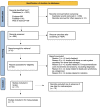Diagnosis of temporomandibular disorders using artificial intelligence technologies: A systematic review and meta-analysis
- PMID: 35980894
- PMCID: PMC9387829
- DOI: 10.1371/journal.pone.0272715
Diagnosis of temporomandibular disorders using artificial intelligence technologies: A systematic review and meta-analysis
Abstract
Background: Artificial intelligence (AI) algorithms have been applied to diagnose temporomandibular disorders (TMDs). However, studies have used different patient selection criteria, disease subtypes, input data, and outcome measures. Resultantly, the performance of the AI models varies.
Objective: This study aimed to systematically summarize the current literature on the application of AI technologies for diagnosis of different TMD subtypes, evaluate the quality of these studies, and assess the diagnostic accuracy of existing AI models.
Materials and methods: The study protocol was carried out based on the preferred reporting items for systematic review and meta-analysis protocols (PRISMA). The PubMed, Embase, and Web of Science databases were searched to find relevant articles from database inception to June 2022. Studies that used AI algorithms to diagnose at least one subtype of TMD and those that assessed the performance of AI algorithms were included. We excluded studies on orofacial pain that were not directly related to the TMD, such as studies on atypical facial pain and neuropathic pain, editorials, book chapters, and excerpts without detailed empirical data. The risk of bias was assessed using the QUADAS-2 tool. We used Grading of Recommendations, Assessment, Development, and Evaluations (GRADE) to provide certainty of evidence.
Results: A total of 17 articles for automated diagnosis of masticatory muscle disorders, TMJ osteoarthrosis, internal derangement, and disc perforation were included; they were retrospective studies, case-control studies, cohort studies, and a pilot study. Seven studies were subjected to a meta-analysis for diagnostic accuracy. According to the GRADE, the certainty of evidence was very low. The performance of the AI models had accuracy and specificity ranging from 84% to 99.9% and 73% to 100%, respectively. The pooled accuracy was 0.91 (95% CI 0.76-0.99), I2 = 97% (95% CI 0.96-0.98), p < 0.001.
Conclusions: Various AI algorithms developed for diagnosing TMDs may provide additional clinical expertise to increase diagnostic accuracy. However, it should be noted that a high risk of bias was present in the included studies. Also, certainty of evidence was very low. Future research of higher quality is strongly recommended.
Conflict of interest statement
The authors have declared that no competing interests exist.
Figures
Similar articles
-
Artificial Intelligence in Temporomandibular Joint Disorders: An Umbrella Review.Clin Exp Dent Res. 2025 Feb;11(1):e70115. doi: 10.1002/cre2.70115. Clin Exp Dent Res. 2025. PMID: 40066511 Free PMC article.
-
Temporomandibular joint assessment in MRI images using artificial intelligence tools: where are we now? A systematic review.Dentomaxillofac Radiol. 2025 Jan 1;54(1):1-11. doi: 10.1093/dmfr/twae055. Dentomaxillofac Radiol. 2025. PMID: 39563454 Free PMC article.
-
The effectiveness of manual therapy applied to craniomandibular structures in the treatment of temporomandibular disorders: protocol for a systematic review.Syst Rev. 2021 Mar 8;10(1):70. doi: 10.1186/s13643-021-01623-7. Syst Rev. 2021. PMID: 33685496 Free PMC article.
-
Artificial Intelligence for Hip Fracture Detection and Outcome Prediction: A Systematic Review and Meta-analysis.JAMA Netw Open. 2023 Mar 1;6(3):e233391. doi: 10.1001/jamanetworkopen.2023.3391. JAMA Netw Open. 2023. PMID: 36930153 Free PMC article.
-
Diagnostic Criteria for Temporomandibular Disorders (DC/TMD) for Clinical and Research Applications: recommendations of the International RDC/TMD Consortium Network* and Orofacial Pain Special Interest Group†.J Oral Facial Pain Headache. 2014 Winter;28(1):6-27. doi: 10.11607/jop.1151. J Oral Facial Pain Headache. 2014. PMID: 24482784 Free PMC article.
Cited by
-
Exploring the Practical Applications of Artificial Intelligence, Deep Learning, and Machine Learning in Maxillofacial Surgery: A Comprehensive Analysis of Published Works.Bioengineering (Basel). 2024 Jul 3;11(7):679. doi: 10.3390/bioengineering11070679. Bioengineering (Basel). 2024. PMID: 39061761 Free PMC article.
-
Novel Diagnostic and Therapeutic Approaches to Temporomandibular Dysfunction: A Narrative Review.Life (Basel). 2023 Aug 25;13(9):1808. doi: 10.3390/life13091808. Life (Basel). 2023. PMID: 37763212 Free PMC article. Review.
-
Artificial intelligence for detecting temporomandibular joint osteoarthritis using radiographic image data: A systematic review and meta-analysis of diagnostic test accuracy.PLoS One. 2023 Jul 14;18(7):e0288631. doi: 10.1371/journal.pone.0288631. eCollection 2023. PLoS One. 2023. PMID: 37450501 Free PMC article.
-
Statistical Methods and Machine Learning Algorithms for Investigating Metabolic Syndrome in Temporomandibular Disorders: A Nationwide Study.Bioengineering (Basel). 2024 Jan 29;11(2):134. doi: 10.3390/bioengineering11020134. Bioengineering (Basel). 2024. PMID: 38391620 Free PMC article.
-
An Examination of Temporomandibular Joint Disc Displacement through Magnetic Resonance Imaging by Integrating Artificial Intelligence: Preliminary Findings.Medicina (Kaunas). 2024 Aug 26;60(9):1396. doi: 10.3390/medicina60091396. Medicina (Kaunas). 2024. PMID: 39336437 Free PMC article.
References
-
- National Institute of Dental and Craniofacial Research. 2018. Facial Pain and its signs and symptoms [accessed 2021 June 10]. http://nidcr.nih.gov
-
- Schiffman E, Ohrbach R, Truelove E, Look J, Anderson G, Goulet JP, et al.. International RDC/TMDs Consortium Network, International association for Dental Research; Orofacial Pain Special Interest Group, International Association for the Study of Pain. Diagnostic Criteria for Temporomandibular Disorders (DC/TMDs) for Clinical and Research Applications: recommendations of the International RDC/TMDs Consortium Network and Orofacial Pain Special Interest Group. J Oral Facial Pain Headache. 2014;28: 6–27. - PMC - PubMed
-
- de leeuw R, Klasser GD. Orofacial Pain-Guidelines for Assessment, Diagnosis and Management. The American Academy of Orofacial Pain, 2018; 5th ed.
Publication types
MeSH terms
LinkOut - more resources
Full Text Sources
Medical




